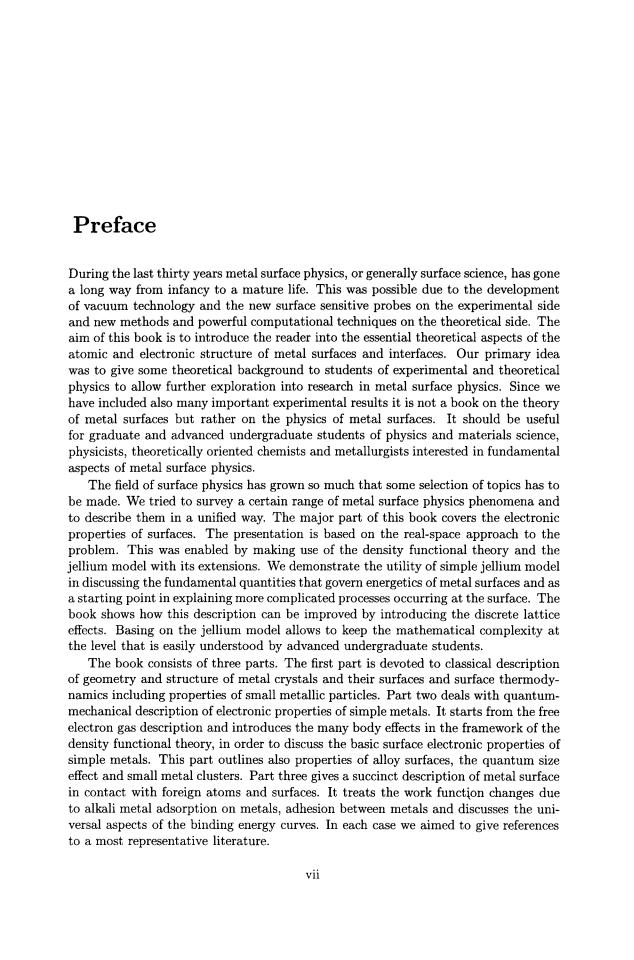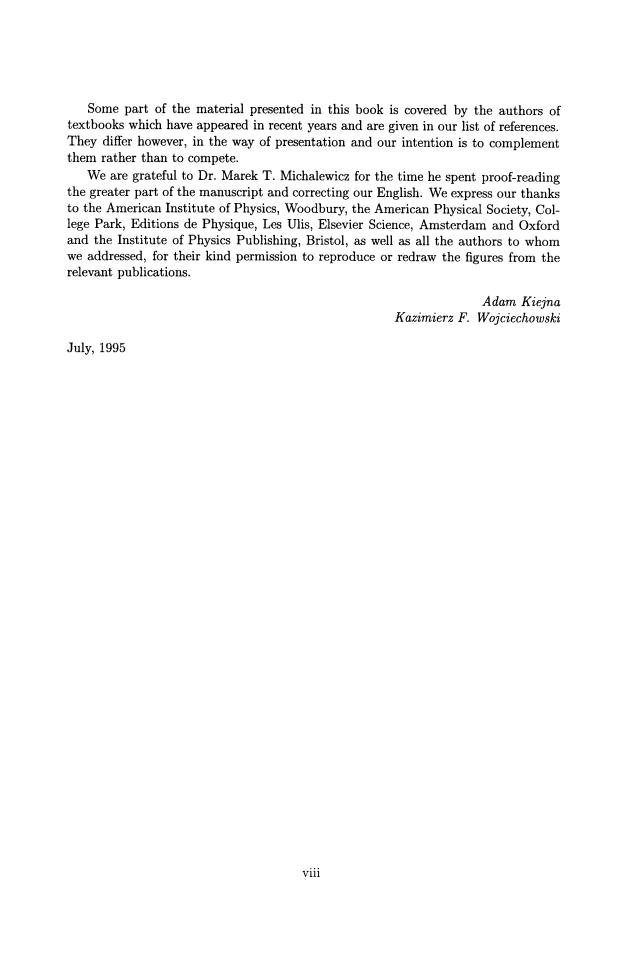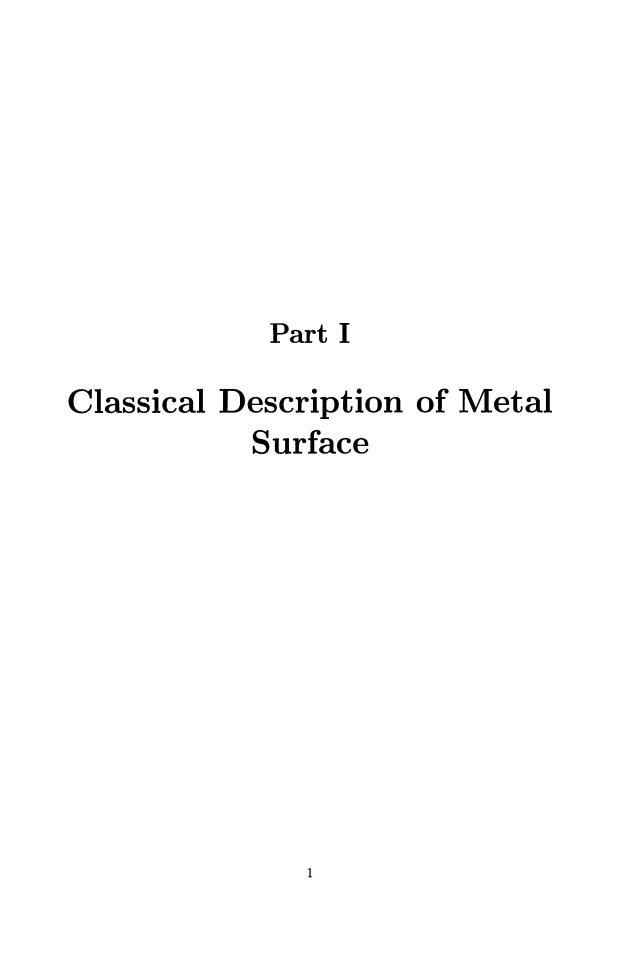
Metal Surface Electron Physics 0080426751
.pdf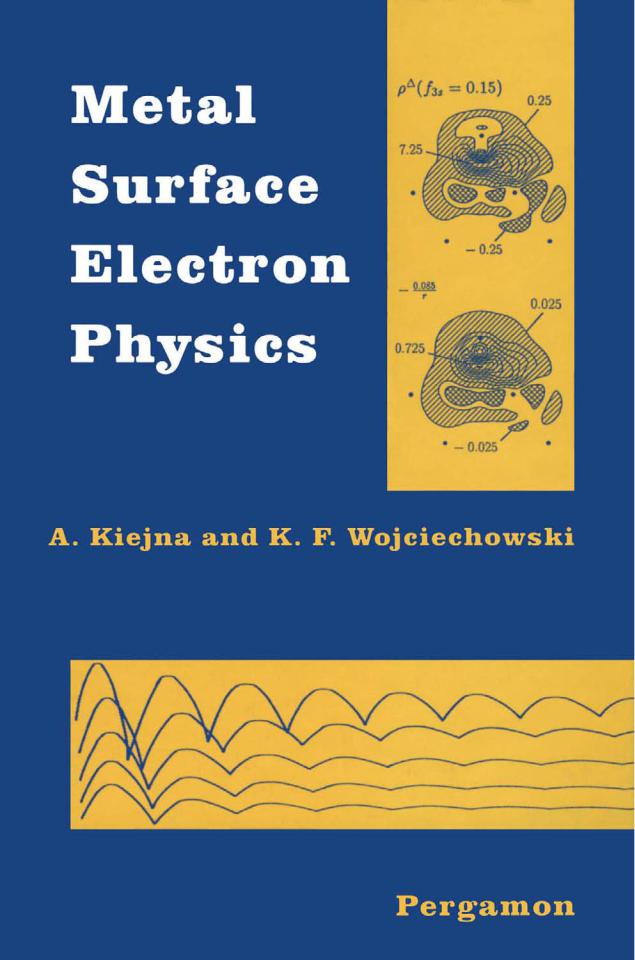
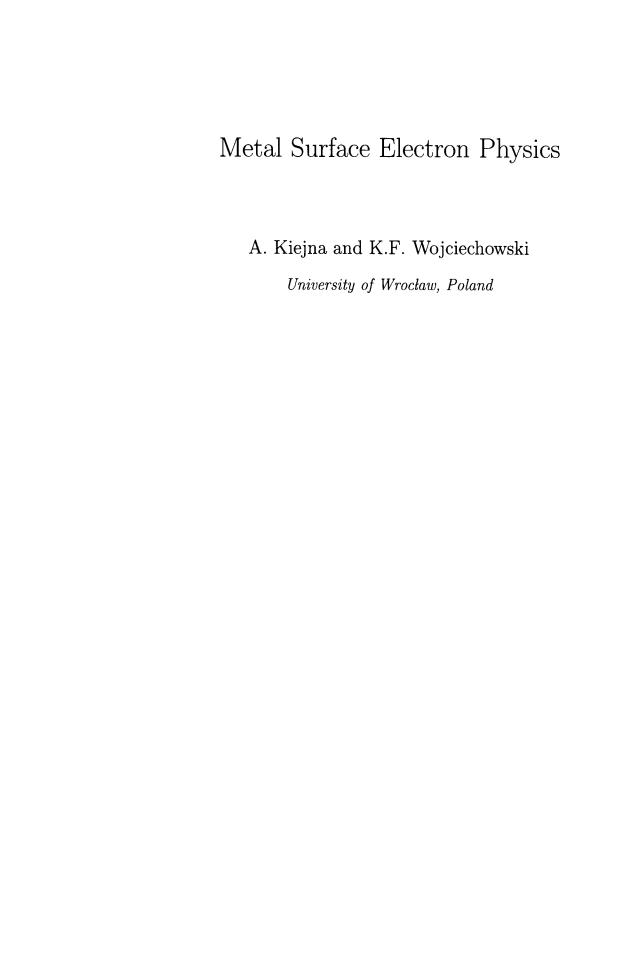
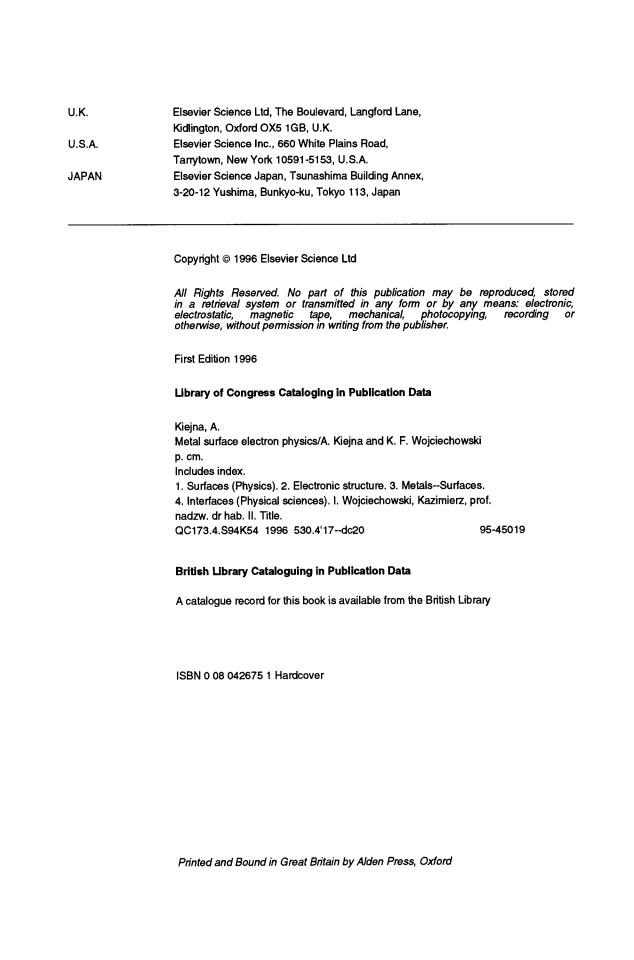

Contents
Preface . . . . . . . . . . . . . . . . . . . . . . . . . . . . . . . . . . . . . . vii
I Classical Description of Metal Surface |
1 |
|||
1 |
The geometry of metal crystals and surfaces |
3 |
||
|
1.1 |
Bravais lattices and metal structures . . . |
. . . . . . . . . . . . . . . . |
3 |
|
1.2 |
. . . . . . . . . . . . . . . . . . . . |
. . . . . . . . . . . . . . . |
|
|
1.3 |
Crystallographic notations . . . . . . . . . . |
. . . . . . . . . . . . . . . |
7 |
|
1.4 |
Some features of the geometrical structure |
. . . . . . . . . . . . . . . . |
10 |
|
1.5 |
Two-dimensional lattices . . . . . . . . . . . |
. . . . . . . . . . . . . . . |
13 |
|
1.6 |
Notations of the real surface structure . . |
. . . . . . . . . . . . . . . . |
16 |
2 |
The surface of real metals |
|
19 |
|
|
2.1 |
General remarks . . . . . . . . . . . . . . . |
. . . . . . . . . . . . . . . |
19 |
|
2.2 |
Lattice relaxation and reconstruction of surfaces . . . . . . . . . . . . |
21 |
|
|
2.3 |
Vibrations of surface atoms and the |
temperature . . . . . . . . |
27 |
3 Thermodynamics of the surface of crystal |
|
33 |
||
|
3.1 |
Basicnotions . . . . . . . . . . . . . . . . . |
. . . . . . . . . . . . . . . |
33 |
|
3.2 |
Equilibrium shape of crystalline particles |
. . . . . . . . . . . . . . . . |
36 |
|
3.3 |
Thermodynamics of microscopic single crystals . . . . . . . . . . . . . |
41 |
|
|
3.4 |
Surface energy, surface tension and surface stress . . . . . . . . . . . . |
45 |
|
|
Quantum Theory of Metal Surface |
51 |
||
4 |
Electrons in metals |
|
53 |
|
|
4.1 |
model . . . . . . . . . . . . . |
. . . . . . . . . . . . . . . |
53 |
|
4.2 |
Infinite and finite potential well . . . . . . . |
. . . . . . . . . . . . . . . |
58 |
|
4.3 |
Jellium model and electrons near metal surface . . . . . . . . . . . . . |
62 |
|
|
4.4 |
Electron gas in the Hartree-Fock approximation . . . . . . . . . . . . . |
65 |
|
|
4.5 |
Exchange and correlation energy . . . . . . |
. . . . . . . . . . . . . . . |
68 |
|
4.6 |
Fermi hole and the origin of image force . |
. . . . . . . . . . . . . . . . |
69 |
|
4.7 |
Stability of jellium . . . . . . . . . . . . . . |
. . . . . . . . . . . . . . . |
71 |
|
4.8 |
Surface energy of semi-infinite free-electron gas . . . . . . . . . . . . . |
73 |
|
...
111

5 |
Electron density functional theory |
77 |
|
|
5.1 |
Thomas-Fermi method and its extensions . . . . . . . . . . . . . . . . |
78 |
|
5.2 |
Hohenberg-Kohn theory . . . . . . . . . . . . . . . . . . . . . . . . . . |
80 |
|
5.3 |
Kohn-Sham equations . . . . . . . . . . . . . . . . . . . . . . . . . . . |
82 |
6 Electron gas near the metal surface |
85 |
||
|
6.1 |
Thomas-Fermi electron density profile . . . . . . . . . . . . . . . . . . |
85 |
|
6.2 |
Self-consistent Lang-Kohn method . . . . . . . . . . . . . . . . . . . . |
88 |
|
6.3 |
Effective potential . . . . . . . . . . . . . . . . . . . . . . . . . . . . . |
89 |
|
6.4 |
The local density of states . . . . . . . . . . . . . . . . . . . . . . . . . |
91 |
7 |
Sum rules and rigorous theorems for jellium surface |
95 |
|
|
7.1 |
The phase-shift sum rules . . . . . . . . . . . . . . . . . . . . . . . . . |
95 |
|
7.2 |
Budd-Vannimenus theorems . . . . . . . . . . . . . . . . . . . . . . . . |
97 |
|
7.3 |
The virial theorem . . . . . . . . . . . . . . . . . . . . . . . . . . . . . |
100 |
8 Surface energy and surface stress |
103 |
||
|
8.1 |
Surface energy components . . . . . . . . . . . . . . . . . . . . . . . . |
103 |
|
8.2 |
Surface energy of jellium . . . . . . . . . . . . . . . . . . . . . . . . . . |
104 |
|
8.3 |
Reintroduction of the discrete lattice of ions . . . . . . . . . . . . . . . |
107 |
|
8.4 |
Variational treatment of lattice effects . . . . . . . . . . . . . . . . . . |
112 |
|
8.5 |
Structureless pseudopotential model . . . . . . . . . . . . . . . . . . . |
115 |
|
8.6 |
Surface stress . . . . . . . . . . . . . . . . . . . . . . . . . . . . . . . . |
119 |
9 |
Work function |
123 |
|
|
9.1 |
The definitions . . . . . . . . . . . . . . . . . . . . . . . . . . . . . . . |
123 |
|
9.2 |
Work function of semi-infinite jellium . . . . . . . . . . . . . . . . . . . |
124 |
|
9.3 |
Discrete-lattice corrections to the work function . . . . . . . . . . . . . |
128 |
10 Work function of simple metals: relation between theory and |
|
||
|
experiment |
131 |
|
|
10.1 Jellium part of the work function .a role of the correlation energy . . |
131 |
|
|
10.2 Work function of the metal bounded by the flat surface . . . . . |
133 |
|
|
10.3 Face-dependent part of work function . . . . . . . . . . . . . . . . . . |
134 |
|
|
10.4 Polycrystalline and face-dependent work functions . . . . . . . . . . . |
135 |
|
|
10.5 Relation between theory and experiment . . . . . . . . . . . . . . . . . |
137 |
|
11 Variational electron density profiles: trial functions |
141 |
||
|
11.1 Introduction . . . . . . . . . . . . . . . . . . . . . . . . . . . . . . . . . |
141 |
|
|
11.2 Conditions satisfied by various exact electron density profiles . . . . . |
143 |
|
|
11.3 Examples of the trial electron density profiles . . . . . . . . . . . . . . |
144 |
|
|
11.4 Smoluchowski’sdensity profile and different contributions to |
|
|
|
|
the energy . . . . . . . . . . . . . . . . . . . . . . . . . . . . . . . . . . |
146 |
iv

Image potential and image plane |
|
153 |
|
12.1 |
Limitations of the classical picture. Image plane position . . . . . . . . |
153 |
|
12.2 |
Linear response of electron system to static perturbing charges . . . . |
157 |
|
12.3 Response of metal surface to a perturbing charge . . . |
. . . . . . . . . |
159 |
|
12.4 The exchange (Fermi) hole near the metal surface . . . |
. . . . . . . . . |
161 |
|
12.5 |
Origin of the image potential . . . . . . . . . . . . . . . |
. . . . . . . . |
165 |
13 Metal surface in a strong external electric field |
|
171 |
|
13.1 |
Electrostatic field at the surface . . . . . . . . . . . . . . |
. . . . . . . . |
171 |
13.2 |
Linear and non-linear contributions to the response . . |
. . . . . . . . . |
177 |
13.3 |
Effect of the ionic lattice . . . . . . . . . . . . . . . . . . |
. . . . . . . . |
179 |
13.4 |
Field induced relaxation and field evaporation . . . . . |
. . . . . . . . . |
181 |
14 Alloy surfaces |
|
187 |
|
14.1 |
The Vegard law and the volume of formation of an alloy . . . . . . . . |
187 |
|
14.2 |
Semi-empirical theory of alloy formation . . . . . . . . |
. . . . . . . . . |
189 |
14.3 |
Surface properties of alkali metal alloys . . . . . . . . |
. . . . . . . . . |
192 |
14.4 Work function of ordered alloys . . . . . . . . . . . . . . |
. . . . . . . . |
194 |
|
14.5 |
Surface segregation . . . . . . . . . . . . . . . . . . . . . |
. . . . . . . . |
198 |
15 Quantum size effect and small metallic particles |
|
203 |
|
15.1 |
The notion of size effect . . . . . . . . . . . . . . . . . . |
. . . . . . . . |
203 |
15.2 |
The non-oscillatory QSE . . . . . . . . . . . . . . . . . . |
. . . . . . . . |
204 |
15.3 |
Oscillatory quantum size effect . . . . . . . . . . . . . . |
. . . . . . . . |
206 |
15.4 Small metallic particles . . . . . . . . . . . . . . . . . . |
. . . . . . . . |
213 |
|
15.5 |
Magic numbers . . . . . . . . . . . . . . . . . . . . . . . |
. . . . . . . . |
218 |
Metal Surface in Contact with Other Bodies |
221 |
||
16 Adsorption of alkali atoms on metal surface |
|
223 |
|
16.1 |
Introduction . . . . . . . . . . . . . . . . . . . . . . . . . |
. . . . . . . . |
223 |
16.2 Work function changes due to alkali metal adsorption. Classical |
|
||
|
picture . . . . . . . . . . . . . . . . . . . . . . . . . . . . |
. . . . . . . . |
224 |
16.3 |
Density-functional calculations . . . . . . . . . . . . . . |
. . . . . . . . |
227 |
|
16.3.1 The model of . . . . . . . . . |
. . . . . . . . . |
227 |
|
16.3.2 The adsorption of single alkali atoms on metallic substrate . . |
232 |
|
16.4 |
Relation between theory and experiment . . . . . . . . |
. . . . . . . . . |
237 |
16.5 |
Sum rules for a metal with an adlayer . . . . . . . . . |
. . . . . . . . . |
240 |
|
16.5.1 Phase-shift sum rule. . . . . . . . . . . . . . . . . |
. . . . . . . . |
240 |
|
16.5.2 Budd-Vannimenus theorem for a |
system . . . . . |
241 |
16.6 Analytical density profiles for jellium-alkali adlayer system . . . . . . . |
242 |
||
V

17 Adhesion between metal surfaces |
245 |
17.1General considerations . . . . . . . . . . . . . . . . . . . . . . . . . . . 245
17.2Adhesion of semi-infinite metallic slabs . . . . . . . . . . . . . . . . . . 247
. . . . . . . . . . . . . . . . . 253
. . . . . . . . . 256
263
18.1Scaling of adhesive binding energies . . . . . . . . . . . . . . . . . . . 263
18.2Universal binding energy curves . . . . . . . . . . . . . . . . . . . . . . 266
Appendices
A |
Fundamental constants . . . . . . . . . . . . . . . . . . . . . . . . . . . |
273 |
A . l |
273 |
|
A.2 |
Atomic units . . . . . . . . . . . . . . . . . . . . . . . . . . . . . . . . |
273 |
A.3 |
The quantities characteristic for the electron gas and screening . . . . |
275 |
B Planar average of the potential difference |
277 |
|
C Surface correlation energy for the Ceperley-Alder |
281 |
|
parameterization |
||
D Linear potential approximation for a metal surface |
283 |
|
E Finite linear potential model |
287 |
|
References |
289 |
|
Index |
|
299 |
vi
